Key takeaways:
Last week did not deliver strategic or operational changes in Ukraine;
Both sides conducted limited attacks in the Kherson Oblast. However, the frontline remained largely unchanged; Ukranians did not move closer to Svatove, while near Kreminna, they may have inched closer to the city;
The frontline in most parts of the Donetsk Oblast also did not change;
Ukrainians are under increasing pressure near Soledar and Bakhmut. Within a few days, Russians captured half of Soledar and posed increasing risks to Kyiv’s control of the city;
Russians did not extend territorial control near Bakhmut as Russians are predominantly preoccupied with Soledar. The pace of Russian attacks on Bakhmut may intensify if Soledar falls;
There were no confirmed changes in the Zaporizhzhia and Kherson Oblasts;
In both regions, Ukrainians continued to conduct high-precision strikes against Russian concentration areas, although based on press releases, the pace of these attacks decreased last week;
We saw no changes in the posture of the Belarusian Armed Forces, and the exercise tempo decreased compared to previous weeks;
Russians deployed new forces and equipment to Belarus, although it is too early to say whether this is a permanent addition or a rotational force;
Before the latest deployments, we estimated that Russians had 10,000 troops in Belarus;
Last week, Ukrainian military intelligence sources claimed that Moscow might place nuclear weapons in Belarus. So far, we have seen no indications this has occurred or is being planned;
The number of Russian artillery attacks decreased last week. Russians averaged out 65 strikes per day, compared to 81 two weeks ago. We assess that the increase was attributed to Moscow’s desire to inflict as much damage as possible on Ukraine in the days leading to the end of 2022.
General outlook
Last week did not deliver any significant shifts on the battlefields in Ukraine. Both sides remained deeply entrenched in their positions with minor exceptions, and the frontline barely moved. Russians achieved the biggest success near Soledar, where they entered the city and captured neighbouring Bakhmutske.
Ukrainians may have made minimal gains west of Kreminna. They also continued to strike Russian rear areas with precision-guided munitions across the entire battlefield in an attempt to degrade Russia’s ability to support and command its forces. To an extent, these strikes have been successful, especially in the Luhansk Oblast, where Russians have not been able to establish any larger forward storage facilities, which, in turn, forces them to move equipment and ammunition deeper from Luhansk Oblast straight to the frontline. Ukrainians thus continue to shape the battlefield while simultaneously preparing for the next large-scale attack.
Kyrylo Budanov, the head of the Ukrainian Main Military Intelligence Directorate (military intelligence), stated last week that Kyiv planned to launch its next major counteroffensive during the spring of 2023. This operation will seek to liberate all Ukrainian territory (“from Crimea to Donbas”) and defeat Russia militarily. It is highly unlikely that Ukrainians will remain passive until then. Indeed, apart from the abovementioned battlefield shaping operations, Kyiv continues to exert constant pressure on Russian forces, especially in Luhansk Oblast, where they attempt to move deeper into the region.
The Russian strategy in this phase of the war is somehow different. Operations in Zaporizhzhia and Kherson Oblasts have been significantly scaled down, although some tactical changes in the former occured. Nevertheless, Moscow’s main priority is to capture the remaining parts of the Donetsk Oblast and concurrently pressure Kyiv in many areas of the front to prevent their armed forces from launching an operational-level winter counteroffensive.
This approach is clearly visible in the Bakhmut area. There, Russians are tieing up even up to ten Ukrainian brigades. The Ukrainian approach seeks to preserve their military potential and combat effectiveness, which focuses on a regular rotation of battalions deployed into combat. On the flip side, this method requires substantial force deployments. Due to constant threats to Bakhmut and Soledar, Russians are tying up around ten Ukrainian brigades in this area alone. This diverts Ukrainian attention from other areas and impacts its capacity to launch a winter offensive. Secondly, thanks to mobilisation, Moscow can now access tens of thousands of reservists that can be sent straight into combat. With little regard paid to the human costs of frontal attacks, Russia can maintain a Bakhmut-like approach in the Donetsk Oblast over the next few months. Rumours are circulating about a possible second wave of mobilisation that is to be announced over the coming weeks. This information has not been confirmed independently, however, if Russia plans to conduct its own strategic operation, it needs to add more men to its ranks.
That is why Ukraine needs more equipment and uninterrupted access to spare parts and ammunition. We believe that the latest round of support packages announced by the United States, France and Germany seeks to improve Ukraine’s capacity to fight over the coming months and prepare to repel Russian offensives in 2023. This year will be crucial for the future of Ukraine.
On Thursday, a joint US-German statement announced the delivery of German Marder infantry fighting and US Bradley fighting vehicles to Ukraine. Berlin is also to send a Patriot battery to Ukraine. As such, the scope of deliveries of western equipment to Kyiv reached a new keystone. The initial tranche will include 50 M2 Bradley vehicles. They will significantly strengthen Ukraine’s mechanised forces’ ability to destroy Russian armour and motor rifle formations in manoeuvre and close battles. Americans plan to train one Ukrainian Battalion at a time. It is thus likely that future deliveries of Bradley are on the table.
Bradley offers speed, mobility, manoeuvrability, protection, and firepower. Its primary weapon is the Bushmaster M242 25 mm automatic cannon. It also has a 7.62 coaxial machine gun and a dual-tube BMG-71 TOW (Tube-Launched, Optically Tracked, Wireless-Guided) missile launcher. Despite its small size, the cannon is capable and can easily penetrate the armour on Russia’s IFVs, especially BMP-1s/2s. The BMG-71 TOW, with a range of over 3,000 meters, also offers Ukrainians a standoff capability when striking Russian tanks. Secondly, Bradleys can also be equipped with a laser range finder linked to GPS depending on which variant is sent. This, in turn, can significantly improve the precision of Kyiv’s artillery fires.
However, as stated in the previous issues of UCM, Ukraine plans to establish three to four new army corps. Each corps is to field three to four brigades. Each Ukrainian mechanised brigade has around 94 infantry fighting vehicles (IFVs) and 31 tanks. So a new corps with three brigades requires 280-370 IFVs alone. We do not know whether the West plans to supply so many vehicles at once, but Ukraine’s needs are vast. Fifty Bradleys are not a lot in this context, even if we count in German Marders and French AMX-10s.
Weather forecast
Last week’s weather forecasts discussed the temperatures reaching “0 degrees Celsius by the start of the following week (9JAN)”. Well, the forecast was incorrect.
The current (Sunday) temperature in the Kharkiv Oblast is -11 degrees Celsius. Freezing temperatures are expected to remain over this part of Ukraine until Saturday when they are to rise to -1 degree Celsius. No snowfall is expected next week.
The weather for Bakhmut is expected to be milder. Sunday (8JAN) is expected to be the coldest (-8 degrees Celsius), with a steady rise as the week progresses. A thaw and temperatures above zero are expected from Friday onward.
Zaporizhzhia will follow a similar weather pattern: freezing temperatures in the first part of the week, with a thaw expected by the end of the week.
If the weather is any indicator, favourable conditions could facilitate larger (armoured) attacks in Ukraine.
Summary of losses
According to the Russian Ministry of Defence, since the start of the war, Ukraine has lost 365 aircraft (+10), 199 helicopters (0), 2,848 UAVs (69), 400 anti-aircraft missile systems (launchers?)(+1), 7,449 tanks and other armoured combat vehicles (+99), 972 MLRS launchers (+15), 3,787 field artillery guns and mortars (+31), as well as 7,859 units of special military vehicles (+106).
According to the Ukrainian General Staff, Russia lost (killed) 111,170 personnel (+4,450), 3,069 tanks (+38), 6,130 armoured combat vehicles (+46), 2,065 artillery systems (+44) and 431 MLRS (+8), 217 anti-aircraft systems (+4), 285 aircraft (+2) and 272 helicopters (+3), and 1,849 UAVs (+57), 4,801 vehicles and fuel tanks (+81), 723 cruise missiles (0), 16 warships and boats (0) and 183 pieces special equipment (+2).
(Numbers in parentheses denote a weekly change).
According to the Ukrainian General Staff, Russians suffered heavy personnel losses last week. Russians lost 4,450 men compared to 4,670 two weeks ago. From a manpower perspective, the loss of 9,120 men over the past couple of weeks equals the loss of more than four regiments. The losses remained high even though the scale of Russian ground attacks increased last week. Last week’s attacks on Soledar and Bakhmut should have increased Russian casualty figures, yet this did not happen.
Frontlines in Ukraine with Russian artillery strikes – 2 JAN – 8 JAN 2023
According to the Ukrainian General Staff, last week, there was a small decrease in the number of locations shelled by the Russian artillery forces. Interestingly, only Charnihiv Oblast, which is free from any ground activity, saw an increase.
Nevertheless, the reduction in the number of strikes was minimal. Taking into context attacks from September-October, the number of strikes remained within the average.
Artillery strikes averaged 65 per day, significantly smaller than two weeks ago when this number stood at 81 per day. In the previous weekly issue, we noted that “on 31DEC, Russians struck Ukraine 101 times, which is above the average of 50-100 strikes that were maintained since October. The question is whether the geographical scope of these strikes will be sustained over the following weeks. The increase in late December could be attributed to Moscow’s desire to inflict as much damage as possible on Ukraine in the days leading to the end of 2022. As such, this rise could be short-lived.” Our assessment appears correct based on last week’s data and the reduction in artillery strikes.
Military situation in Belarus
Last week did not bring significant changes affecting the general situation in Belarus. Probably, due to the beginning of the year and Orthodox Christmas, the activity of the Belarusian political and military representatives was somewhat limited. Nonetheless, the Belarusian Army received new military equipment and conducted some training exercises. On the contrary, the activity of the Russian Armed Forces in Belarus was significantly heightened compared to previous weeks. On the one hand, already deployed forces were conducting training exercises. On the other, new trains with reservists arrived in the country.
The 2023 years started with two political changes that affected the Belarusian Armed Forces. Firstly, the new state budget increased defence spending by more than BYN1 billion, which is more than 60 per cent. Consequently, Belarusian defence spending increased by 100 per cent within two years.
This is a serious increase, which was also observed in the case of Belarusian internal affairs bodies, as well as the State Security Committee of the Republic of Belarus (KDB), also known as KGB, which noted BYN340 million and BYN100 million increases in their budget. Nevertheless, the armed forces enjoy the highest growth in their budget. Even if we take inflation into account, which was expected to rise to 16 per cent in 2022, 2023 marks a 45 per cent increase in the defence budget in real terms. Notably, part of the national security budget devoted to mobilisation training also increased, but by a “modest” 18 per cent, which marks a slight increase in real terms. It is possible that this part of the budget was purposefully decreased to mask Belarusian mobilisational activities that have been ongoing since mid-2022. However, this is speculation.
Secondly, Belarusian President Alexander Lukashenko approved new admission rules for higher education. Those changes also affected the military education system. Currently, the children of military service members who became disabled during their duty will be enrolled on the universities of power agencies (MoD, MIA, State Border Committee, etc.) outside of competition. This also pertains to the pupils of military-patriotic clubs. Besides, the number of necessary tests taken by future Belarusian soldiers will be limited. After new changes, applicants of certain specialities will be only obliged to pass two of them – language and a profile subject.
Regarding the actions of Belarusian political leadership, on Friday, Lukashenko visited the 230th Combined Arms Training Ground. He paid the visit accompanied by the highest military representatives, where he met with Russian service members deployed in Belarus.
After listening to their reports, Lukashenka thanked them for their presence and expressed his satisfaction that Russia and Belarus are working for a common cause. As claimed by the Belarusian President, joint training actions also positively affect the Belarusian Army. Later, Lukashenko presented a few trucks filled with medical equipment for unspecified Russian commanders. They all contained new med kits, which Lukashenko’s son had created(?). According to Belarusian Commander-in-Chief, they were made after a detailed analysis of foreign med kits and significantly outperformed their NATO equivalents.
As noted above, the activity of the Belarusian military representatives was rather average. A few generals assisted Lukashenko during his trip to 230th Combined Arms Training Ground. This pertains to the Belarusian Minister of Defence, Lt. Gen. Viktor Khrenin, who personally confirmed the quality of new Belarusian first-aid equipment, and to his Deputy, Maj. Gen. Andrey Zhuk stated that the Russo-Belarusian grouping was coordinated at the platoon-company level and actively prepared for the upcoming joint exercises and staff training. As stated by Zhuk, those actions are meant to prepare the combined forces for the main training event that will be carried out at the end of 2023 – the Union Shield 2023 exercise. He did not mention that Zapad-2023 is also earmarked for 2023, at least according to Sergei Shiugu, Russia’s Minister of Defence. There are thus conflicting reports about what exactly will be practised this year. Some drills may be deception exercises that mask the true intent of creating a joint grouping of forces that will eventually be deployed to Ukraine, as was the case with the “Allied Resolve” exercise conducted in Belarus in the build-up to the war in February 2022.
Secretary of the State Security Council, Lt. Gen. Alexander Volfovich, also commented on the joint grouping of forces. On Friday, he claimed that the deployment of additional Russian troops was meant to cool the western “hot heads”, who were planning aggression against Belarus.
Similar statements were also delivered on Tuesday by the Deputy Commander of the Belarusian Air Force and Air Defence Forces for Ideological Work, Col. Anatoly Bulavko. According to him, the whole Belarusian Armed Forces were ready for any course of action and the development of the political-military situation. Bulavko noted that the specified elements of the Belarusian Army were constantly engaged in combat duties during the new year holidays, which surprised their western counterparts.
Referring to the actions of Belarusian generals, the Belarusian Minister of Defence met with his Tajikistan counterpart, Col. Gen. Sherali Mirzo. The meeting was used to discuss the security issues in the CSTO area of responsibility and the bilateral military cooperation between Tajikistan and Belarus.
Last week, training activities of the Belarusian mechanised formations were evident. On Tuesday, they involved elements of the 11th Mechanised Brigade. They included the field exit combined with live ammo firing of the 2S1 Battalion from the 841st Artillery Group and engineering classes of the 40th Mechanised Battalion’s servicemen.
A day later, training actions were undertaken by the 11th and 120th Mechanised Brigades as well. Precisely, tank crews of the latter trained indirect T-72 firing at the 227th Combined Arms Training Grounds, while soldiers of the abovementioned 40th Mechanised Battalion were involved in the tactical medicines classes. Besides, the 227th Combined Arms Training Ground hosted BMP-2 and BTR-82A firing exercises of the 72nd Joint Training Center cadets. In addition, the training range of the 120th Mechanised Brigade was a place for the 339th Mechanised Battalion’s weapon training.
On Thursday, once again, the elements of the 120th Mechanised Brigade were visibly active. This appertains to the service members of the 40th and 105th Mechanised Battalions that took part in the sniper firing and engineering classes, respectively. The company commanders of Belarusian SOF formations were involved in the gathering linked to the combat training organisation carried out simultaneously in Brest. Also, the Belarusian KDB (KGB) started anti-terror exercises in the Vitebsk and Minsk regions.
Regarding the actions of the Belarusian Armed Forces, moderate activity was observed on Wednesday and high on Friday. On Saturday, the anti-air alert was activated in Salihorsk at night. The reasons behind the incident remain unclear. According to unofficial sources, the activation had an unauthorised character.
It was also announced on Sunday, 8JAN, that Belarus and Russia would conduct a joint tactical flight exercise between 16JAN-1FEB. Russian aviation component participating in the drill also reportedly arrived in Belarus on Sunday. According to the official Belarusian MoD press release, the exercise will involve all air bases and training grounds of the Belarusian Air Force and Air Defense Forces.
Last week, the number of military transfers of Belarusian military equipment was limited. Nonetheless, a convoy consisting of more than 25 trucks was observed on Thursday. Also, single movements involving two S-300 launchers and R-450M2 communications complexes were spotted throughout the week.
It should be added that on Thursday, a battalion set of BTR-82A APCs arrived in Brest from Russia. Vehicles will reinforce the 38th Air Assault Brigade and replace BTR-80 APCs used by one of the formation’s battalions.
On the other hand, the activity of the Russian Armed Forces was clearly apparent. Dozens of trucks and light vehicles were observed throughout the week. Moreover, several military echelons’ arrival was reported at the end of the week. On Friday, three echelons with various military equipment arrived in Belarus. Despite trucks and logistic equipment, they presumably included division-level communications assets, anti-air guns, and tracked and wheeled APCs. What is more, some videos even showed the presence of Russian SPHs in Belarus. Nonetheless, they still need to be confirmed.
Besides, the air component was also strengthened. On Tuesday, another A-50U AEW&C (RF-50608) arrived at Machulischy Air Base. During the week, the airframe conducted two flights escorted by MiG-31K supersonic interceptor aircraft (RF-92445 and RF-92215). Moreover, nine Russian Mi-8 and Mi-24 helicopters arrived at the same base on Sunday.
Not only did additional military equipment start to arrive in Belarus. On Friday and Saturday, at least two military echelons with passenger cars arrived in Vitebsk. Each train could carry at least 780 Russian soldiers.
In peacetime, each passenger car carries 52 soldiers. In wartime, this number can increase twofold, so as many as 3,000 reservists may have arrived in Belarus last week. However, we must also remember that this may be a rotation component: new forces came in, and “old” ones returned to Russia. Since the first trains with Russians arrived in Belarus in October, their withdrawal to Russia would confirm that Russian forces undergo a two-three month-long basic training. We need to wait for satellite imagery to see whether any of the accommodation areas at training ranges were recently expanded.
On Wednesday, a representative of the Ukrainian HUR, Yuri Yusov, discussed the possibility of Russian provocation pertaining to the deployment of Russian nuclear weapons in Belarus and Crimea. According to Yusov, such plans were considered by Russian President Vladimir Putin and were confirmed by the HUR and other allied intelligence agencies. We have seen no indications to suggest that nuclear weapons have been deployed to Belarus.
Summary of main Belarusian training activities in January 2023
5JAN: Gathering dedicated to the organisation of combat training measures (Brest, Belarusian SOF subunit commanders)
4JAN: BTR-82A and BMP-2 firing classes (227th Combined Arms Training Ground, cadets of the 72nd Joint Training Center);
4JAN: T-72 indirect firing classes (227th Combined Arms Training Ground, tank crews of the 120th Mechanised Brigade);
3JAN: Engineering training classes (unspecified location, elements of the 40th Mechanised Battalion of the 11th Mechanized Brigade);
3JAN?: Field exit combined with live ammo firing (230th Combined Arms Training Ground, 2S1 Battalion of the 841st Artillery Group of the 11th Mechanised Brigade)
The situation at selected axes and directions
Kharkiv/Luhansk direction
Last week did not deliver any operationally significant developments despite both sides being actively engaged in (counter)offensive operations. Apart from minimal frontline alternations west of Kreminna, the Kharkiv Oblast’s frontline remained unchanged.
But let’s start will artillery strikes. Apart from battlefield strikes, Russia launched numerous strikes on mostly civilian areas in border regions last week. Such strikes have been ongoing for several weeks already and closely resemble Russian strikes on civilian infrastructure in the Kherson Oblast. In the Kharkiv region, Russians, too, launch unguided missiles from S-300 air defence complexes or MLRS systems. The objective is to degrade Ukrainians’ willingness to fight and make their lives miserable by creating hardships (lack of electricity) and causing economic loss and death. Such measures are unlikely to deliver anticipated results. Despite this, as long as Russian artillery is deployed in border areas, the Russian artillery strikes will continue.
For the second week in a row, we did not record any Russian ground attacks on Ukrainian settlements and villages in the border areas. Despite this, a threat of such, albeit limited, attacks persists. They are unlikely to deliver even minimal gains but force Ukrainians to deploy their forces near the border instead to more pressing areas.
Moving south, there was at least one Russian attack near Lyman Pershyi towards Synkivka. However, it did not alter the frontline.
Ukrainians also made no gains towards Nyzhnia Duvanka. Novoselivske remains contested. This small village has witnessed heavy fighting recently as Ukrainians attempted to extend their control along the R-66 highway leading to Svatove. In this respect, Ukrainians did not move closer to Svatove last week.
Ploshchanka remains under Russian control.
Previously, we have marked Charvonopopivka as liberated by Ukrainians. Last week’s reports were quite conflicting and contradictory. Some suggested that Russians took back control over the village, while others indicated the Ukrainians still maintained a presence there near the R-66 highway. Indeed, A Ukrainian source noted a small extension of territorial control near Chervonopopivka. Specifically, the UAF managed to improve their position to the north of the settlement. Fighting continued in the village and near highway R66. A Ukrainian source claimed that it was there where Ukrainians reached the highway. However, no visual evidence has been provided to support this claim. On the other hand, a Kyiv-based Centre for Defence Strategic think-tank noted on Wednesday that Russians deployed up to five BTGs from the 74th and 55th Separate Motorised Rifle Brigades and pushed Ukrainians away from Chervonopopivka and took the village under complete control.
Most changes occurred west of Kreminna, although adjustments were minimal in the grand scheme of things. Ukrainians are very slowly pushing Russians from Dibrova towards Kuzymne. In this sector, Kyiv perhaps pushed Russians a couple of kilometres to the east. There were no changes south of Kreminna, where Ukrainians were present around 5 kilometres from the city. That said, the situation for Russians in this sector can swiftly change. A Ukrainian attack along’s Kreminna’s western borders can effectively cut off Russian formations near Dibrova and force their collapse. That said, even if this happens, the impact on the battle for Kreminna will be minimal.
Last week, several Russian sources claimed that Russians planned to conduct a large-scale attack from the Kreminna area towards Zarichne and Lyman. Indeed, according to Oleksii Arestovych, an advisor to the President’s Office, Russia has concentrated forces to attack Ukrainian positions in this direction. He claimed two Russian generals recently visited Russian positions near Kreminna to supervise a large-scale attack after the previous attempt failed two weeks ago. Serhiy Haidai, the Luhansk Regional Military Civil Administration Head, reiterated these comments. On Thursday, Russians deployed new forces into the sector to address Ukrainian gains made near Kreminna and the ongoing threat Kyiv poses to Russian presence there. Haidai added that frozen ground should allow heavy equipment to move forward, which also pertains to the Russians. He did not comment on whether Moscow had plans for the near future. He added that the UAF were gradually liberating the territory of the Luhansk region, but he did not provide any details about these developments.
So far, we have seen no indications that Russians were indeed preparing for such an operation. While they may have appropriate manning levels of poorly trained reservists, they do not possess adequate equipment to make such an attack work.
Kharkiv and Luhansk Oblast will remain deadlocked until one side deploys sufficient force to pierce through another’s defences.
On Thursday, Serhiy Haidai, the Luhansk Regional Military Civil Administration Head, reiterated his comments from Wednesday about the build-up of Russian personnel in the Kreminna area. He claimed that Russians deployed new forces into the sector to address Ukrainian gains made near Kreminna and the ongoing threat Kyiv poses to Russian presence there. Haidai added that frozen ground should allow heavy equipment to move forward, which also pertains to the Russians. He did not comment on whether Moscow had plans for the near future. He added that the UAF were gradually liberating the territory of the Luhansk region, but there were no confirmed or reported territorial changes in the oblast on Thursday.
Last week, Haidai claimed Ukrainian strikes on Russia’s rear forced the attackers to deliver ammunition from Luhansk straight to the Svatove area. No larger ammunition storage warehouses could be established near the frontline due to the threat of Ukrainian artillery attacks. Consequently, this strains Russian logistics capability and capacity to maintain the appropriate tempo of attacks and artillery strikes.
Donetsk Oblast Direction
Last week, most changes occurred in the Donetsk Oblast. However, they were limited to the Bakhmut-Soledar area. The frontlines in the remaining parts of the oblast remained largely unchanged. As such, this chapter will primarily discuss the situation near Bakhmut.
Starting from the north, the intensity and number of Russian attacks on Verkhnokamianske and Spirne decreased last week. This could be explained by the redeployment of forces from these areas either to Soledar-Bakhmut or, slightly further north, to Yakovlivka. Indeed, the capture of Yakovlivka allowed Russians to conduct assaults towards Vesele, Rozdolivka or Vyimka. All of these avenues were reconnoitred by force last week. We can expect the Russian effort in this direction to be sustained at least over the next couple of weeks, especially if Soldar falls.
Moving onto Soledar, the battles for the city began in early August. Since then, the city has been under Ukrainian control as Russians were kept a few kilometres east of the city. It is this surprising that since the fall of Yakovlivka, Ukrainian defences near Soledar became weaker. There are conflicting reports about where the frontline currently lies in the city. However, Russians passed through Bakhmutske and are now at least near the train station. Our sources in the city claimed that Russian success can only to attributed to one thing: countless ground attacks, irrespective of losses. We were told that there was wave after wave of soldiers being sent to capture the city, and Ukrainians were becoming overwhelmed. Our other sources confirmed to us that Russian presence in Soledar and Bakhmut is mainly limited to infantry supported by artillery. There is little or no armour involved in Russian attacks.
We have also heard an unsubstantiated rumour that Russian airborne forces are deployed near Soledar too.
Another rumour is that Ukrainians counterattacked on the night of 6/7JAN and pushed Russians to the east. However, here again, we have not been able to confirm the veracity of this claim yet.
Also concerning is the situation near Krasna Hora, which last week saw an increased tempo of Russian attacks, threatening Ukrainian positions in the village. If it falls, Russians can attack the Ukrainian rear either in Soledar or Bakhmut.
In Bakhmut, Russians are near the Artwinery and do not appear to have extended their territorial control since the last week. Most of Opytne remains under Russian control; here, too, Russian progress stalled.
Going back to the border Soledar-Bakhmut area, we believe that Ukrainians maintain some forces in reserve. Perhaps, as many as several brigades. These brigades are already involved in combat. Specifically, each brigade deploys a battalion or two, which are then rotated every week or two. As such, this allows for continuous deployment of fresh troops into combat. It preserves their combat potential and effectiveness and creates a reserve force large enough to forestall Russian attacks if all units are deployed. However, it is unclear whether all combat potential will be used to this effect now.
Last week, Russians made limited gains near Klishchiivka and were probably near the city’s eastern outskirts.
No other changes occurred in the Donect Oblast last week.
Russians remained offensively oriented near Avdiivka. They interchange artillery attacks with ground assaults, but to no effect.
During the previous week, there were attacks on Vodyane, Mariinka, Pobieda, Nevelske, Pervomaiske, and Novomykhailivka.
Mariinka remains contested, but control areas barely moved last week. The control over the town is split in half.
Zaporizhzhia direction
Last week did not deliver major changes on the front in this direction. However, Russian territorial control may have been slightly expanded.
Specifically, Russian sources claimed to have captured Dorozhnyanka, some seven kilometres south of Hulajpole. We have not been able to confirm this development independently. Ukrainian sources deny the loss of the settlement, although last week, they conducted limited counterattacks near Dorozhnyanka. This indicates that Russians may have indeed had some success near Hulajpole.
Last week, Russians also conducted a raid in Novopokrovka. We recorded no other ground attacks in this direction.
The attack on Dorozhnyanka was reportedly preceded by a 10 km Russian raid from Myrne, indicating that Russians could move around their formations without detection near the frontline.
That said, we do not assess that this development will have major operational consequences. We continue to see no Russian preparations for a large-scale Russian attack in the Zaporizhzhia Oblast.
The UAF continued to strike the Russian rear in the Zaporizhia Oblast.
There were reported explosions in Tarasivka, Basan, Polohy, Vasylivka, Tokmak and Dorozhnyanka. Several explosions were also heard in Berdyansk. Targets engaged included concentration areas and command posts. In Tokmak, according to Russian sources, Ukrainian hit a military hospital. The Russian MoD confirmed a Ukrainian strike on Tokmak but did not provide the casualty rate.
On 4JAN Russian air defence was also activated in Melitopol, suggesting a missile/UAV activity.
Kherson direction
There were no confirmed changes in the Kherson Oblast. Neither side appears to be preparing for a major offensive operation in this direction. Their focus is firmly placed on conducting artillery and missile strikes along the frontline. At the same time, Ukrainians also continue to engage Russian targets at Russia’s operational depth to grade their ability to support and control their forces logistically.
Last week’s key event regarding ground activities was the battle for the Potemkin Island in the Dnipro delta, south of Kherson. Conflicting reports emerged about the situation on the island. A video appeared online on Monday showing a Ukrainian flag on Potemkin. At that time, a Ukrainian MP, Oleksiy Honcharenko, claimed that the area had been liberated. Ukrainian Kherson Oblast Military Advisor Serhiy Khlan also stated on Tuesday that the island might have been cleared.
However, responding to these reports, Natalia Humeniuk, Head of the United Coordinating Press Center of Security Defense Forces of South, said that it was still too early to talk about the liberation of Potemkin. She added that any comments about the military situation could significantly affect the course of military operations in this area.
This probably indicates that Ukrainians are effectively fighting to liberate the area.
Indeed, the Head of the Ukrainian Joint Press Center of the Tavrisk Direction Defence Forces, Yevhen Yerin, stated on Wednesday that Russians were rebuilding their forces in Zaporizhzhia and Kherson Oblasts. Russians are also reportedly active in islands on the Dnipro River. Yerin added that neither side controls the islands. But Ukrainians, according to Yernin, prioritise taking the east bank of the Dnipro River.
However, as of Sunday, 8JAN, no information suggested that the Ukrainian military controlled the island.
Last week, the UAF increased the number of attacks on Russian targets in the Kherson Oblast. Specifically, they targeted a Russian concentration area in Havrylivka Druha, reportedly wounding 100 Russian personnel. Explosions were also heard in Chukalivka, Fedorivka, Chaplynka, Radensk, Oleshky and Khakovka.
According to Serhiy Bratchuk, Odesa Military Administration Spokesperson, Ukrainians targeted an S-300 storage warehouse in Radensk.
Air defences also fired on unspecified targets over Sevastopol and Dzhankoi in Crimea on 2JAN and 3JAN.
Outlook for the week of 9JAN – 15JAN
In assessing the probability or likelihood of certain events, we will use a set of terms followed by the US Intelligence Community.
We have decided to introduce more accountability to our forecasts. Therefore, each weekly update assesses how correct (or incorrect) our predictions were. Here is what we said last week. Please also remember that while we try to remain as objective as possible regarding our performance, the reader will ultimately have to decide how (in)accurate we have been.
Last week’s forecast
This is what we forecasted last week:
“When it comes to the Kharkiv Oblast, we continue to maintain that the Russians are unlikely to capture any territory. There is a roughly even chance that Ukrainians will liberate villages in the oblast. We are particularly looking at areas northwest of Svatove.” This forecast was a mixed bag. On the other hand, Russians made no progress in the Kharkiv Oblast, but neither did Ukrainians near Svatove. The entire area is heavily contested as both sides attempt to shift the frontline daily without much result.
Score: 0.5/1
“While Russians will likely conduct some limited counterattacks, we assess that they are unlikely to recapture territories in the Luhansk Oblast. We estimate that there is a roughly even chance that Ukrainians will progress near Kreminna. It is likely that Ukrainians will reach Kreminna next week, but the city is unlikely to be captured.” We were largely, but now wholly, incorrect in this forecast. Russian counterattacks did happen. Russians may have recaptured Chervonopopivka, so they may have extended their territorial control north of Kreminna. On the other hand, Ukrainians made minimal progress west of Kreminna but did not reach the city.
Score: 0/1
“Moving south, Russians maintain an offensive posture across the entire Donetsk Oblast. Apart from Opytne, they made no progress there last week. We largely expect this to be the case also next week. It is unlikely that Russians will make significant gains, but there is a roughly even chance that some villages will be captured.” Russians indeed made no significant gains last week in the Donetsk Oblast, but they likely captured Bakhmutske.
Score: 1/1
“It is highly unlikely that Russians will capture Bakhmut, Soledar and Vuhledar.” Neither of these cities was captured last week, but the fall of Soledar is a real possibility as of Sunday, 8JAN.
Score: 1/1
“We do not expect to see any major changes in the Zaporizhzhia Oblast. The frontline is highly unlikely to change. We see no indications that either side is preparing for a large-scale attack. Likely, next week will again feature positional battles and artillery exchanges. Ukrainians will also likely continue to strike Russian units, concentration areas and storage facilities within the HIMARS range.” This forecast was accurate.
Score: 1/1
“The same goes for the Kherson Oblast. We expect to see no major changes in this direction next week. The chances are remote that either side will conduct a river crossing operation. However, Russians are almost certain to continue striking civilian infrastructure targets in the city of Kherson and other settlements in the region. Likewise, Ukrainians will highly likely continue shelling Russian positions south of the Dnipro River.” This forecast was accurate.
Score: 1/1
“We also do not expect to see any changes in Belarus. It is highly unlikely that Belarus will join the war next week, although its military exercises will highly likely be ongoing. “This forecast was accurate.
Score: 1/1
Final score: 5.5/7
Next week’s forecast
Last week saw increased Russian ground attacks east and southeast of Dvorniche in the Kharkiv Oblast. We largely expect these actions to continue. However, it is unlikely that Russians will turn this activity into a larger-scale attack or that it will deliver new territorial gains.
We assess that there is roughly even a chance that the situation around Svatove in the Luhansk Oblast will change. The frontline in this sector is heavily contested and, with a couple of exceptions, largely frozen. Social media posts warned last week about the possibility of a Russian counterattack west of Kreminna. We would not like to attach a probability score to this event due to a lack of data, but we assess that Ukrainians are likely to get closer to the city. We are unable to say whether they will reach the city next week.
The situation in the Donetsk Oblast will remain fluid. It is unlikely that Russians will make even tactically significant gains in all areas, apart from the Bakhmut-Soledar axis. In this area, Ukrainian positions are increasingly pressed, and withdrawal is a real possibility. In this context, we assess that it is highly likely that Russians will move deeper into Soledar. There is roughly even chance that the city will fall. If Soledar falls, then Ukrainians may be forced to withdraw from Krasna Hora to avoid encirclement.
Bakhmut is highly unlikely to fall next week, but Russians are likely to make progress in the city.
Russians will also likely capture more territories near Bakhmut, such as Pidhorodne.
It is highly unlikely that next week will deliver major changes in the Zaporizhzhia Oblast. Although some tactically insignificant frontline shifts could occur, the situation will not change operationally. Ukrainians will continue missile strikes on Russia’s rear.
The chances are remote that the situation in the Kherson Oblast will change. Neither side will conduct a river crossing operation. We expect to see no major ground attacks, but there is roughly even chance that Ukrainians will capture Potemkin Island. Ukrainian high-precision strikes will also continue on Russian areas north of Crimea.





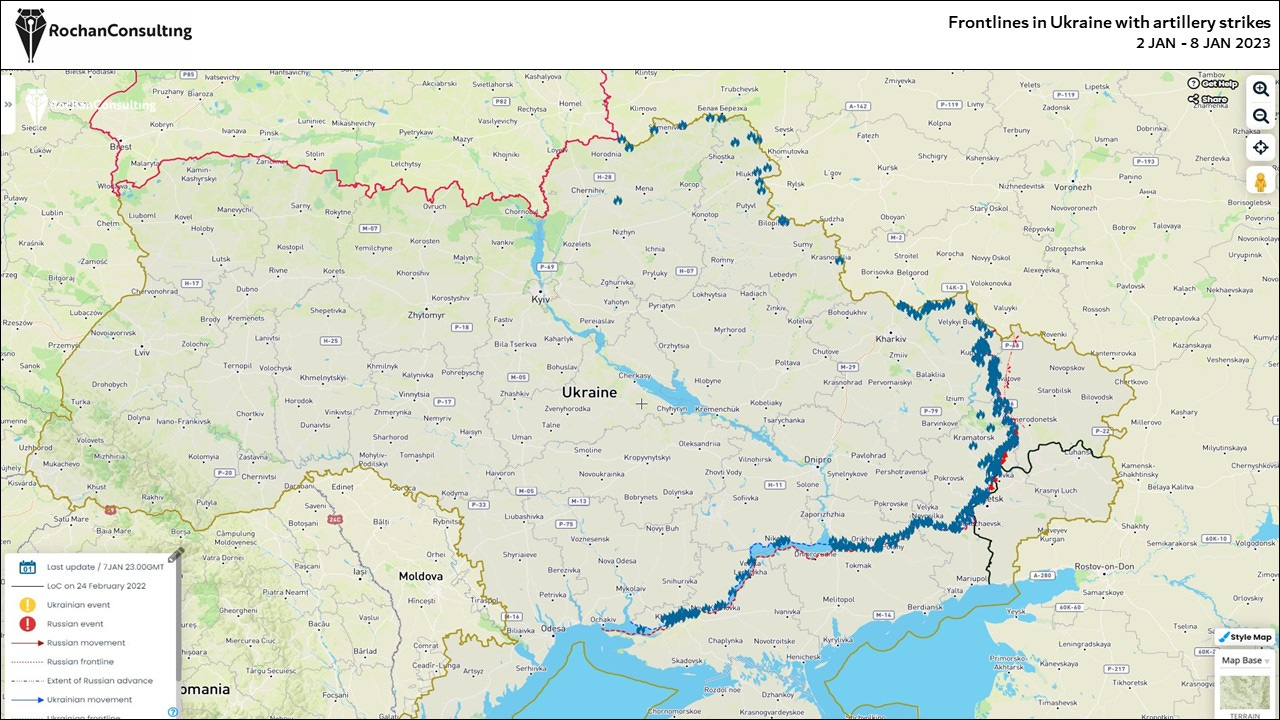
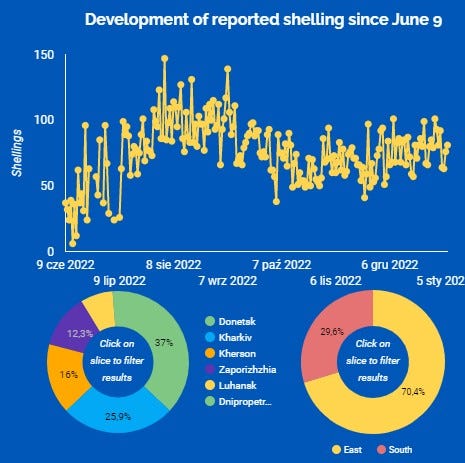

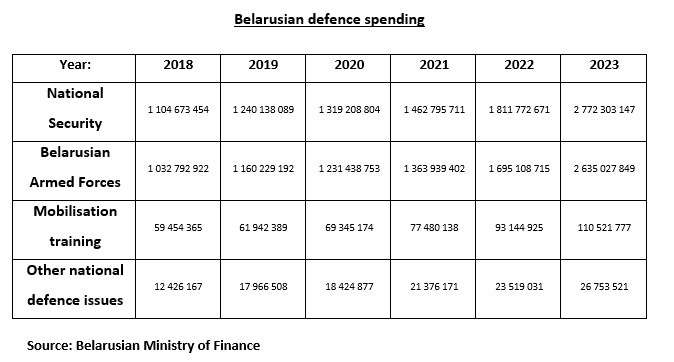
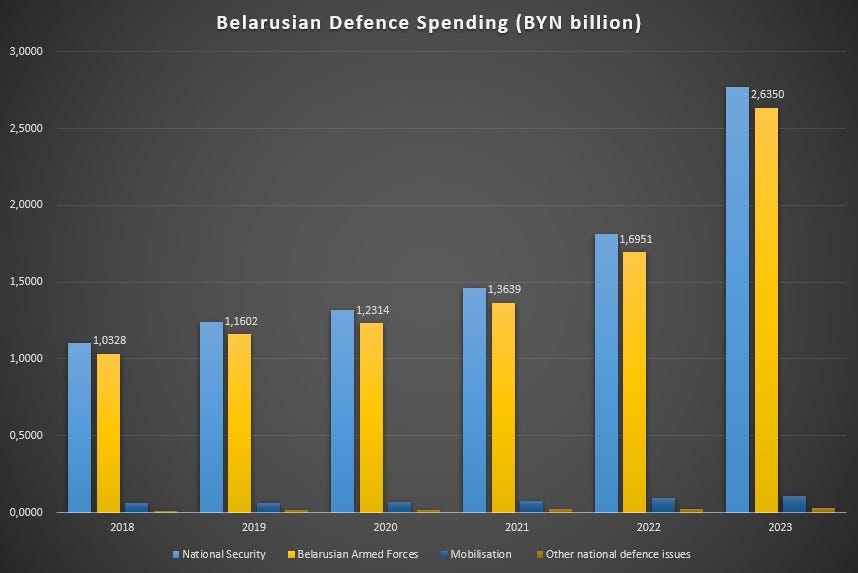

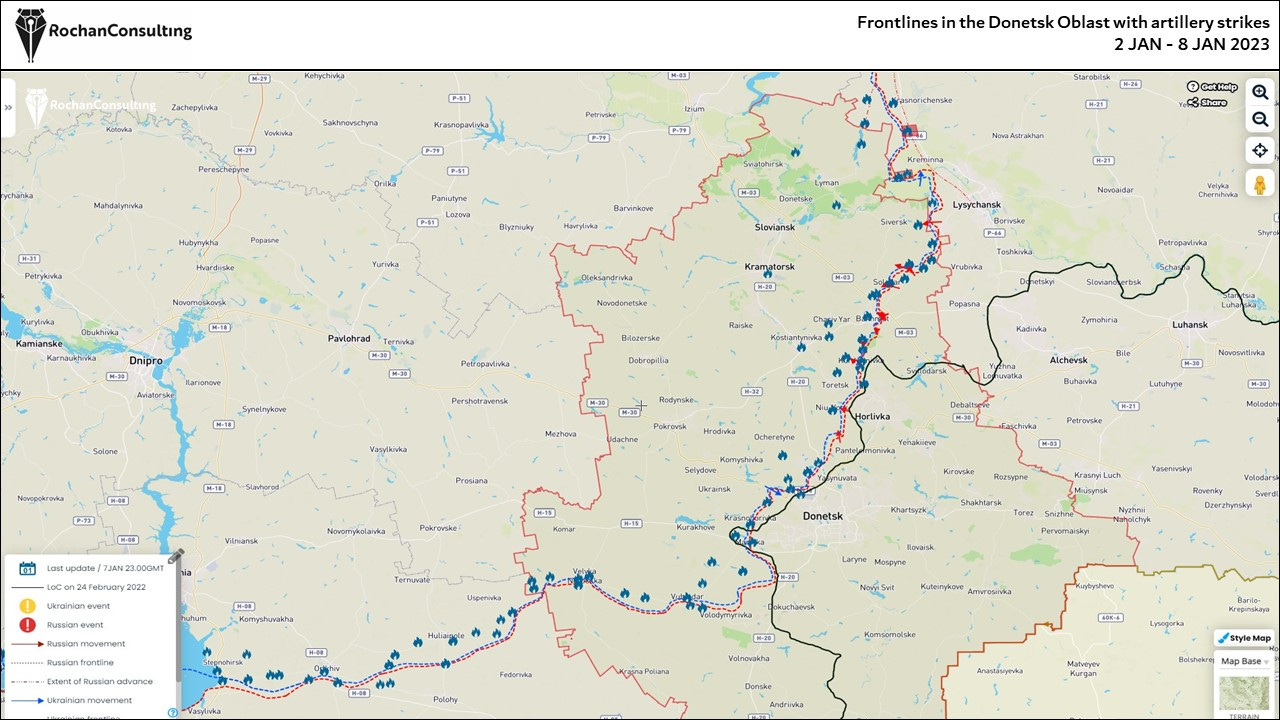
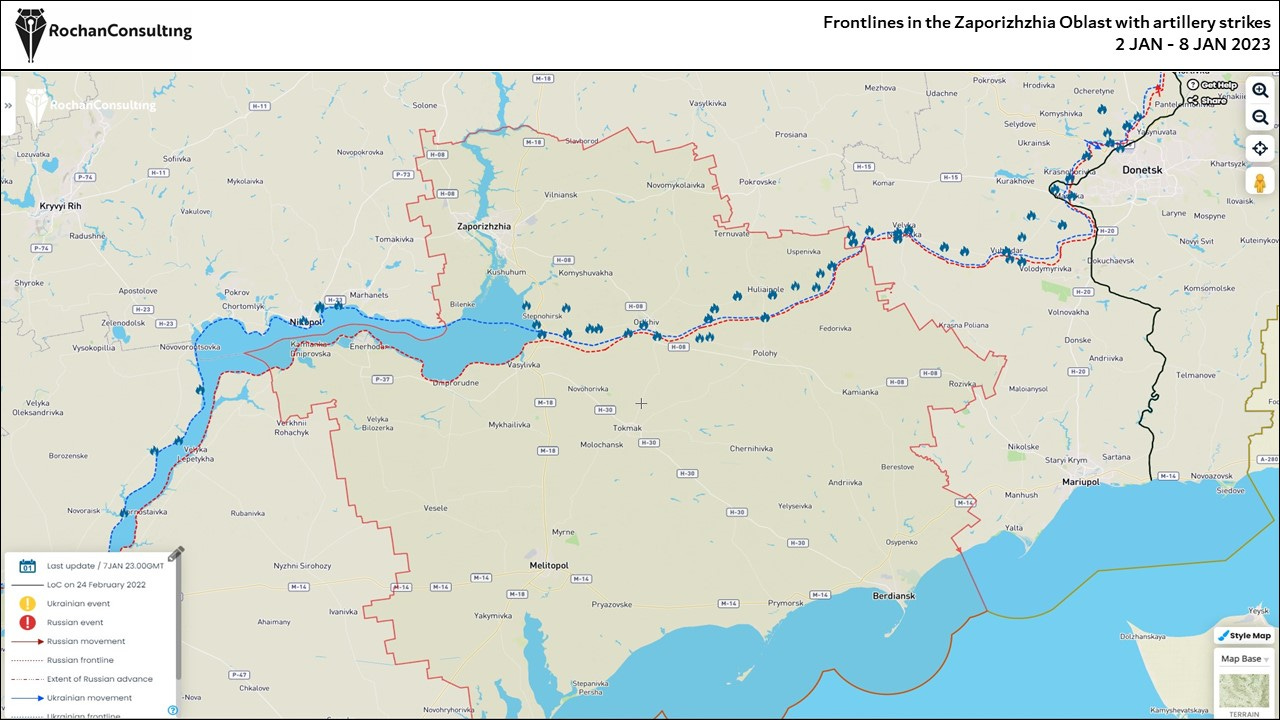
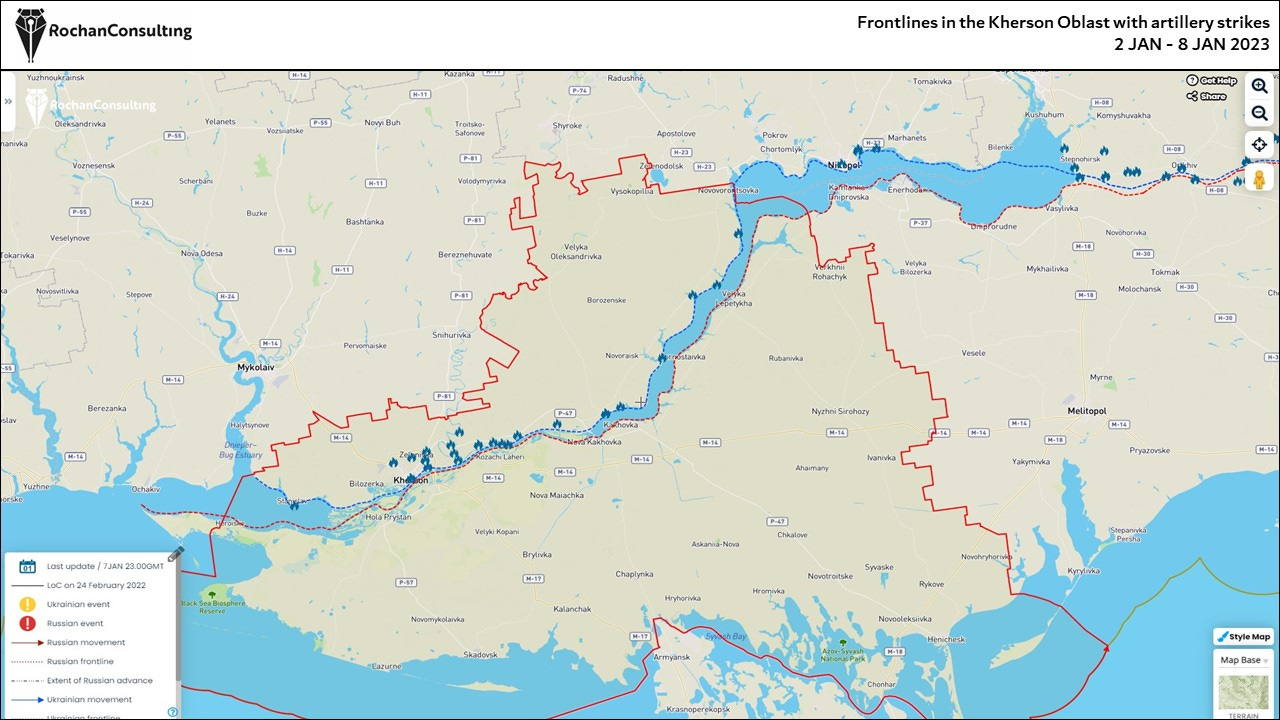

Analysis much appreciated!
Does anyone have insight into Russian force concentrations inside RU borders? The potential deployment of the ~200k reservists likely undergoing intensive training and outfitting since October remains concerning.
Working theory: rumors of limited artillery supplies in Donbas, continued limited use of Russian tactical aviation, reliance on Wagner mercenaries on active sectors, lack of committment of armor near Soledar, and major UKR forces remaining tied down near Bakhmut is setting the stage for a new front to open later in January.
Given Ukraine's US-mandated restrictions on using HIMARS on RU territory, were I the Russian commander I'd be building up forces near Belgorod and Kursk for a sudden attack towards Poltava. Likely preceded by a concerted effort to secure air superiority over the new front line relying on saturating UKR defenses with Shahed drones.
Objective: get as close to the Dnipro as possible to threaten UKR supply lines supporting the fight in Donbas. If Kharkiv can be cut off from Kyiv through winter while a new round of mobilization prepares replacements for the additional ~100k casualties RU forces will suffer, RU might believe this will push Kyiv into talks.
If correct, obviously the solution is to give Ukraine more and better weapons faster. An exposed Russian spearhead cut off and forced to surrender could be the final turning point... one can only hope.
Thanks for not being one of those outlets that parrots the US line on everything. You've been *far* more reliable than certain DC-based think tanks this past year.